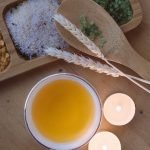
Corn oil is an oil rich in omega 6 and omega 9, it is useful for regulating blood cholesterol levels and against constipation. Let’s find out better.
Features of corn oil
Corn oil is extracted from the sprouting (called germ) part of the caryopsis of the zea mays plant seed, commonly called corn. This plant is native to the Americas and is currently widespread in the world.
The extraction yield of the oil is not very high, in fact it is only 15-20% on the entire whole part of the corn seed. This is a limit even if it is currently exceeded by the fact that the corn seed is widely used to obtain the starchy part (corn starch) for the preparation of packaged bakery and other processed products, to have a large basin to draw on to obtain corn oil.
Corn oil has a dark, amber red color, and only after refining it acquires a clear and clear appearance. The temperature threshold is 140 ° C and for this characteristic it can be used occasionally for cooking fried even if olive oil is always better; moreover, using raw oils as a condiment is always the most correct nutritional choice to maintain all their properties unaltered.
Properties and use of corn oil
Its composition is rich in polyunsaturated fats of the omega-6 family (30%) and omega-9 (55-60%). On the contrary, it is free of omega-3 and this composition is to be kept in mind since it is recommended to take a right ratio between omega 6 and 3 (respectively of 4: 1). This parameter tells us that if we want to use corn oil in the diet we must supplement omega 3 with other foods such as linseed oil.
In corn oil there are no proteins and this allows it to be used for those who have problems with excess uric acid and high azotemia or even in cases of liver problems and intoxications.
Plant phytosterols have been found in its composition and this brings benefits from the point of view of the management of blood cholesterol levels and consequently lower risk of cardiovascular diseases. The chemical structure of plant phytosterols is similar to that of cholesterol, which triggers a competition that reduces the absorption of cholesterol in the intestine. This property is called cholesterol-lowering and is due precisely to the presence of polysaturated acids.
It also contains a good dose of vitamin E useful for improving some dermatoses and skin problems such as eczema and redness, even in children. Vitamin E is an excellent antioxidant to reduce and counteract free radicals responsible for cellular aging, among other things. In 10 g of oil, which correspond to a tablespoon, we can have 30% of RDA (recommended daily dose) of vitamin E. The only warning to have the safety of the presence of vitamin E is linked to the processing methods to obtain the oil: if it is raw we have many more principles and nutrients inside the oil while if instead retification treatments are performed then gradually substances are lost and first of all it disperses the precious vitamin E.
Corn oil can also contain provitamin A always if the extraction oil is raw and therefore can be considered a useful supplement always to strengthen and balance the skin and hair.
The composition of mineral salts sees the presence of iron and some other trace elements depending on the stage of transformation of the oil extraction process.
Corn oil has a good laxative action thanks to the fact that at the intestinal level its absorption is lowered, this involves its elimination with the fecal mass that will be softer favoring mechanical emptying and facilitating in cases of constipation. Used in cosmetics for base as massage oil, for nourishing creams for sensitive and dry skin.
It is also used as a base for after-sun lotions. Regarding the skin, the most appreciated property is to give elasticity to the epidermis and make it soft and hydrated.
With corn oil it is possible to prepare soap, in fact the saponificable fraction is 2% and the oil contains sterols, phospholipids and gamma-tocopherol. It can be used for saponification with the creation of natural soaps also handmade by hand. The consistency of the soap obtained from corn oil alone is softer than the common soap even if it carries with it the typical properties of this oil; it is also very stable. Corn oil soap gives the skin hydration, delicacy and has good emollient properties. In the field of renewable energy, corn is used to produce bioethanol and biofuel depending on whether it is transformed or used directly as biomass.
Curiosity
The Corn plant is one of the symbols of the Mayan people and as early as 3000 a.C. one of the staple foods of these indigenous peoples of the Amariche. In Europe it was imported after the discovery of Christopher Columbus and took some time for its diffusion; its name GranTurco served to underline its exoticism, thus being recognized by Europeans as foreign food: Strange wheat of the Turks even if Turkey had nothing to do with the area of origin of this food.
DIY soap recipe with corn oil
To prepare a cold homemade soap starting from corn oil is not so difficult if you carefully follow the safety rules, since among the ingredients there is caustic soda.
Ingredients: 1 kg of corn oil, 300 gr water, preferably distilled, 136 gr of caustic soda. Optional 10-15 drops of essential oil of your choice, a tablespoon of flour to fix the essence and natural dye.
Warnings: caustic soda is quite dangerous so you need to have glasses, mask, gloves and use plastic, glass or wood materials for each step (never metal). Always pour caustic soda into the water and never vice versa!
Procedure: Weigh the corn oil and prepare a pot to heat it to 45 °C on the stove. At the same time take a bucket-like container and pour the 300 grams of water, carefully weigh the caustic soda using a disposable plastic cup and then pour the soda into the water. At this moment we will have a reaction that will release heat up to 80 ° C.
We wait for the solution to drop to a temperature of 45 ° C and then add the caustic solution in the oil still at 45 ° C and blend with the immersion blender. We will see the saponification begin, this is called the ribbon phase, which creates a consistency similar to the cream and we can add the flour impregnated with essential oil and possibly a natural color (turmeric, saffron, cinnamon) chosen. We pour the mixture into molds such as silicone pastry molds or by recycling jars and containers of milk and plastic yogurt. We wrap in woolen blankets and leave for 2 or 3 days to rest in a dry and warm place.
Then we extract from the molds and possibly cut the formed soap into slices and leave for at least 2 months to mature so that no traces of soda remain. The proof that it is ready is to try the soap and seeing that the skin remains soft: if it were to pull after washing it will mean that the soap will have to mature a few more weeks.






